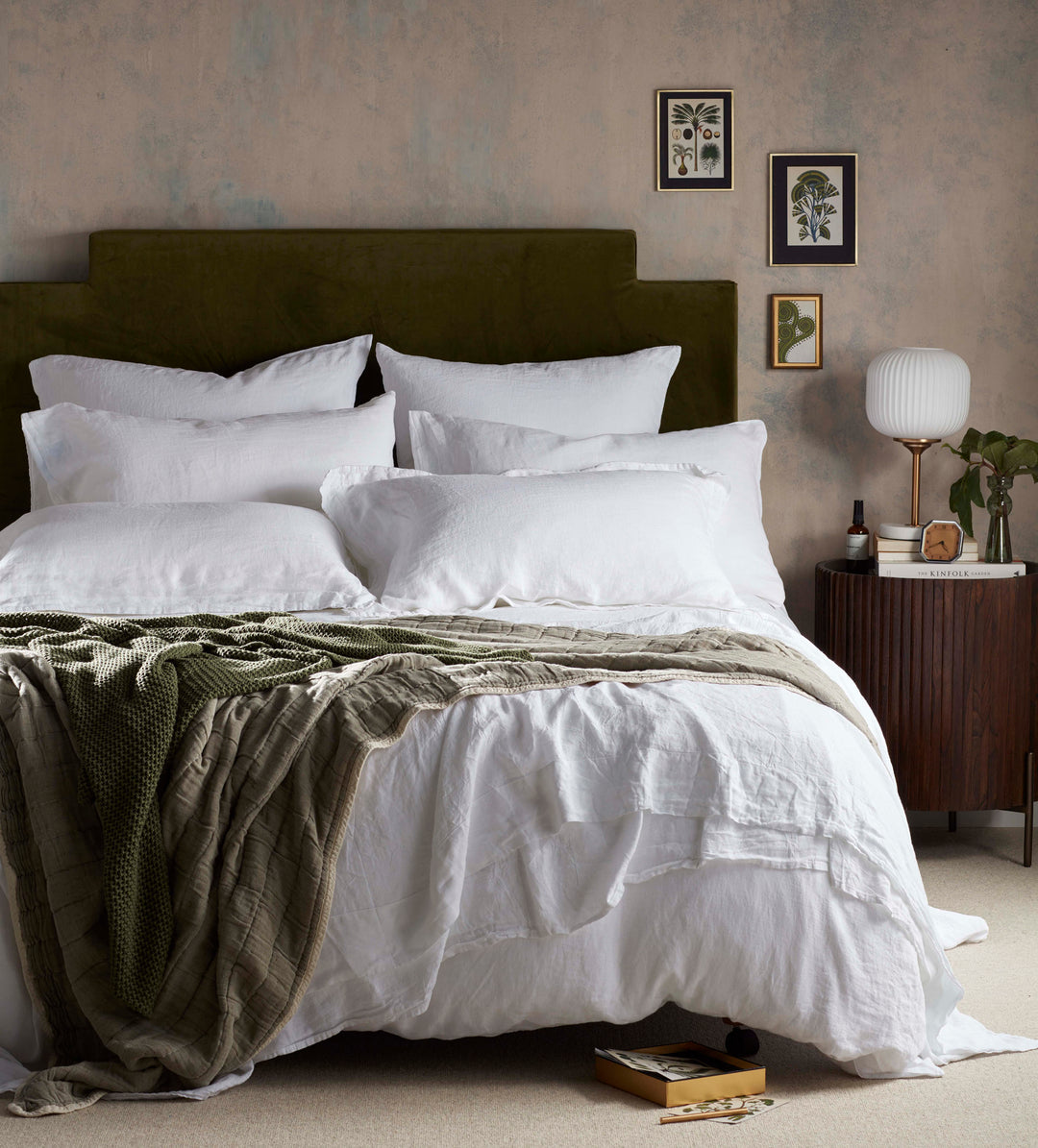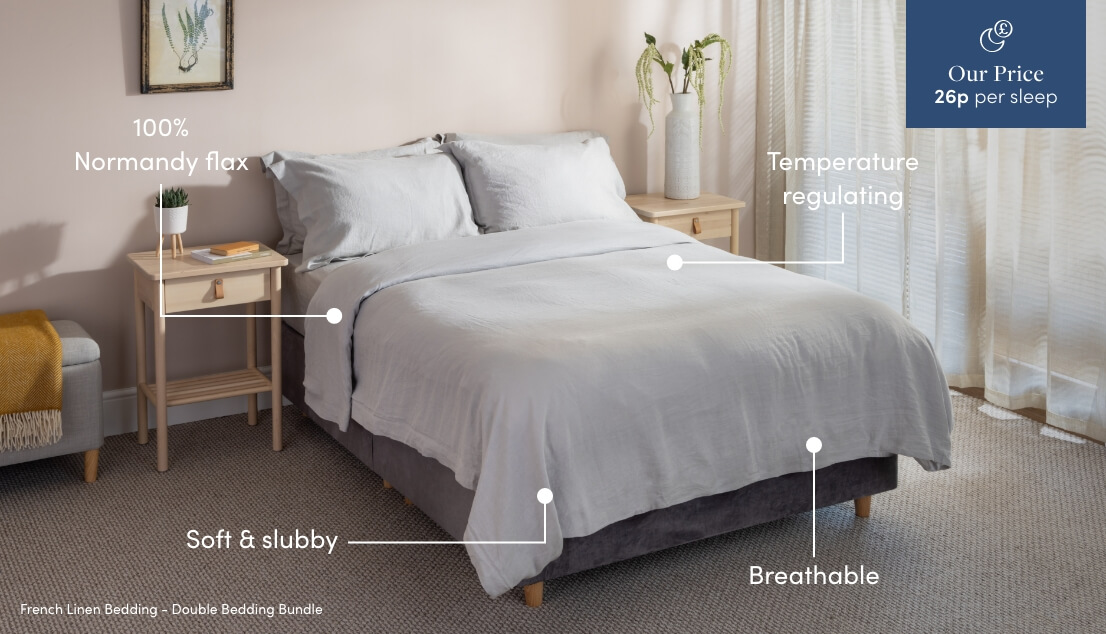Australia Linen FAQs: Everything First-Time Buyers Ask
Australia Linen FAQs: Everything First-Time Buyers Ask
Blog Article
Understanding Bed Linen: The Eco-Friendly Alternative for Comfortable Living
When you think concerning environment-friendly fabrics, bed linen frequently attracts attention for its special qualities. This natural fabric, made from the flax plant, provides both convenience and sustainability. Its remarkable buildings make it an optimal option for cozy climate and lasting usage. But what absolutely sets linen apart from other products? Recognizing its origins and advantages can transform exactly how you check out home fabrics. Let's check out the remarkable globe of linen even more.
The Beginnings of Bed Linen: From Flax to Textile

Bed linen, among the earliest fabrics understood to mankind, has a remarkable trip that begins with the simple flax plant. You may be shocked to find out that this plant prospers in trendy environments, growing in areas like Europe and components of Asia. When gathered, the flax stalks go through a process called retting, where they're soaked to divide the fibers from the woody components. After retting, the fibers are brushed and spun into yarn, ready for weaving.
When you see bed linen material, you're seeing centuries of craftsmanship. The weaving procedure changes those spools of thread right into the lovely, sturdy fabric you like. Linen has actually been treasured for its natural appearance and really feel, making it a preferred for everything from apparel to home fabrics. Following time you touch linen, remember its abundant history that connects you to old cultures and their typical methods.
The Unique Feature of Linen
Among the standout features of this amazing material is its breathability. When you wear bed linen, you'll observe just how it allows air to flow, maintaining you cool on hot days. This residential or commercial property makes it a perfect selection for summer apparel and sheets.
Linen also boasts outstanding moisture-wicking capacities, drawing sweat away from your skin and permitting it to vaporize promptly. You will not really feel clammy, also in humid problems. In addition, linen is durable, commonly coming to be softer and extra comfy with each wash, which means it can stand the examination of time in your closet.
One more unique aspect is its all-natural appearance; the mild abnormalities provide bed linen a personality that improves your design. And also, it resists creases far better than lots of various other fabrics, so you can take pleasure in a loosened up yet brightened appearance without much effort. Embrace bed linen, and you'll appreciate its comfort and distinct beauty.
Environmental Advantages of Bed Linen
When you select bed linen, you're not simply selecting a gorgeous textile; you're likewise supporting sustainable production practices. Linen's compostable and biodegradable nature makes it a clever option for the environment. And also, it needs substantially less water to produce compared to various other textiles, helping preserve this priceless source.
Lasting Production Practices
Although several materials have considerable environmental influences, linen stands apart due to its sustainable production techniques. When you choose bed linen, you're going with a textile made from the flax plant, which requires minimal water and chemicals. This resilient plant can thrive in inadequate soil conditions, decreasing the requirement for chemical plant foods. In addition, the entire flax plant is used in production, lessening waste and promoting source effectiveness.
Bed linen manufacturing is commonly less energy-intensive contrasted to other fabrics, as it entails natural processes rather than artificial therapies. By supporting linen, you're adding to an extra lasting fabric industry that prioritizes environmentally friendly methods. Choosing bed linen not just enhances your comfort but likewise aligns your worths with environmental responsibility.
Eco-friendly and Compostable Product
Bed linen's green nature prolongs beyond its lasting production; it's compostable and additionally biodegradable, making it a superb option for ecologically mindful consumers. When you pick bed linen products, you're opting for materials that damage down normally, returning nutrients to the planet. Composting linen can enrich soil, advertising healthy and balanced plant growth.
Low Tide Consumption
One of the standout advantages of linen is its reduced water usage during cultivation. Unlike cotton, which needs significant watering, bed linen's flax plant thrives on minimal water, making it an extra lasting choice. You'll value understanding that for every heap of bed linen created, considerably much less water is required contrasted to lots of other textiles.
Bed linen vs. Various Other Fabrics: A Contrast
When you contrast bed linen to other textiles, you'll notice its superior breathability and convenience, making it ideal for warm climate. And also, linen stands apart for its resilience and longevity, typically lasting longer than many generally utilized materials. As you consider your selections, the environmental effect of each fabric will likewise play a necessary role in your choice.
Breathability and Convenience
Bed linen stands out amongst materials for its amazing capacity to enable air circulation. Unlike artificial materials, which can trap warm and wetness, linen's all-natural fibers wick away sweat, keeping you completely dry and trendy.
Cotton is typically applauded for its gentleness, but it does not match bed linen's breathability. Also blends could not use the same ventilation. If you prioritize comfort, specifically in summer season, bed linen needs to be your best option. It not only maintains you really feeling fresh but additionally brings a classic sophistication to your wardrobe.
Longevity and Durability
While lots of fabrics supply differing degrees of durability, linen absolutely excels in longevity, making it a sensible investment for your closet. Unlike cotton or artificial products that may put on out swiftly, bed linen gets stronger with each clean. You'll discover that linen's breathable nature also lowers wear from sweat and moisture, which can harm other textiles.
Environmental Effect Comparison
Although several textiles add to environmental issues, linen stands apart for its green high qualities. Unlike cotton, which calls for large water sources and pesticides, linen is made from flax, a plant that prospers on marginal water and needs less chemicals. This means you can really feel great about your selection while decreasing your carbon impact.
When compared to synthetic textiles like polyester, bed linen's biodegradability radiates. While polyester can take hundreds of years to break down, bed linen breaks down naturally, returning nutrients to the soil.
Selecting linen not just advertises lasting farming techniques however additionally sustains a healthier earth. By choosing for linen over traditional fabrics, you're making a mindful decision that benefits both your comfort and the setting.
Taking care of Your Linen Textiles
To guarantee your bed linen fabrics stay in excellent condition, you'll want to adhere to some uncomplicated care standards. Clean your linen in chilly water on a mild cycle to prevent it from reducing or shedding its form.
When it pertains to drying, air drying out is ideal. Pick a low heat setting and remove the items while they're still a little damp to lessen creases if you use a clothes dryer. Iron the linen while it's still damp for much easier handling, or vapor it to keep it looking crisp.
For storage space, maintain your linen in an awesome, dry area. Prevent direct sunshine to stop fading. With these easy practices, your bed linen textiles will certainly preserve their beauty and last for several years, making them a sustainable addition to your way of life.
Incorporating Bed Linen Into Your Home Design
Caring for your linen textiles not only preserves their high quality however also opens a world of opportunities for integrating them right into your home decoration. You can begin little by including linen throw cushions to your sofa, instantly raising the room with structure and heat. Consider linen drapes that filter sunlight magnificently, creating a soft, airy ambience in any space.
For a more rustic look, try using linen tablecloths or joggers throughout dishes; they include a classy touch and are very easy to tidy. If you're really feeling daring, mix and match different linen shades and patterns to develop an one-of-a-kind, split result.
Do not ignore linen coverings-- curtain one over a chair or your bed for a welcoming feel. By thoughtfully incorporating bed linen right into your style, you boost both convenience and design, making your home a peaceful retreat.
The Future of Linen in Sustainable Living
As consumers increasingly focus on sustainability, linen becomes a frontrunner in environmentally friendly textiles. Its manufacturing utilizes less water and chemicals compared to conventional cotton, making it an extra ecologically responsible selection. As you look towards a lasting future, incorporating linen right into your closet and home can substantially reduce your carbon impact.
Cutting-edge brands are now concentrating on lasting practices, from using natural flax to carrying out circular economic situation principles. You'll find that bed linen's sturdiness means it lasts much longer, decreasing the demand for regular Linenshed substitutes.
In addition, as more people welcome minimalist way of livings, bed linen's timeless charm and versatility will keep it pertinent. By choosing linen, you're not simply choosing convenience; you're additionally sustaining lasting techniques.
In the upcoming years, the demand for linen is expected to expand, strengthening its area in a more eco-conscious world. Take into consideration making linen a staple in your sustainable living journey.
Regularly Asked Inquiries
Is Linen Appropriate for People With Allergic Reactions?
Yes, linen's natural fibers are hypoallergenic, making it suitable for people with allergies. Its breathable nature helps in reducing moisture and bacteria build-up, adding to a much healthier sleeping environment. You'll likely find it comfy and secure.
Can Linen Be Dyed Easily?
Yes, you can color bed linen quickly. Its natural fibers absorb dyes well, permitting for lively colors. Just make sure you make use of the ideal dye type and adhere to appropriate techniques to achieve the wanted outcomes without damaging the textile.
Exactly How Does Linen Contrast in Durability to Cotton?

What Weight of Linen Is Ideal for Summer Season Apparel?
For summer season garments, lightweight linen around 4 to 5 ounces per backyard is excellent. It maintains you great, breathable, and comfortable in heat (Linen Australia). You'll value exactly how it drapes and relocations with you effortlessly

Can Linen Be Utilized for Outdoor Furniture?
Yes, you can utilize linen for outside furniture. It's breathable and resilient, making it an excellent option for warm weather condition. Just make certain to select a dealt with variation to hold up against the components and keep its look.
Final thought
Integrating linen into your life not just boosts your convenience however also sustains an extra sustainable future. By choosing this environmentally friendly fabric, you're making an aware choice that benefits both your well-being and the earth. With its special residential properties and very little environmental impact, bed linen is a wise choice for your home décor and way of living. Welcome linen, and enjoy the excellent blend of style, toughness, and sustainability in your everyday living.
Bed linen's biodegradable and compostable nature makes it a wise selection for the environment. By including linen right into your home, you're not just enjoying its convenience and sturdiness; you're additionally supporting green methods and aiding develop a healthier world. The Future of Bed Linen in Sustainable Living.

Report this page